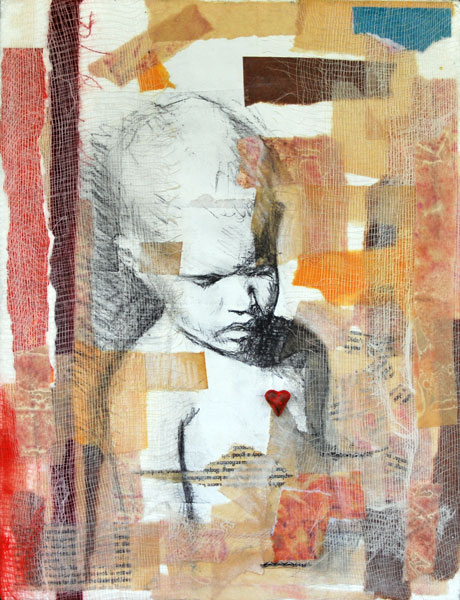
Our star makes her getaway, as only she can.
I do a lot of photography, but like many people with artistic pretensions I also enjoy working with other media from time to time.
I suppose my favorite plastic medium is assemblage, pulling together odds and ends to make a whole that is (hopefully) greater than the sum of its parts — a useful way, incidentally, to use up the bits of rusty metal and torn cardboard and odd pieces of broken glass that accumulate in my “stuff I might need someday” box out on the porch. I enjoy the purely mechanical aspect of attaching one thing to another, in ways that were never intended by the original manufacturer, to achieve an effect, or make a statement.
As with any form of expression, of course, before you start talking, you need to have something to say. For this purpose I keep a list of topics — people, concepts, lines from books or poems, anything that might provide a possible jumping-off point — from which I can sometimes pull something to expand into a project.
Consider Medea, the barbarian sorceress who helps Jason and the Argonauts steal the Golden Fleece from her father. (We all saw the 1963 movie version, with Nancy Kovak — best remembered for the fluffy orange fur vest she wore in an episode of the original Star Trek a few years later — and Todd Armstrong fighting skeletons by Ray Harryhausen.) The story of Medea is one that has been pretty thoroughly exhausted in art and theatre over the past three thousand years, but that is probably because it is just so damned appealing: beautiful witch, handsome but fickle hero, monsters, Hercules, chariot pulled by dragons, mechanical bronze giant, more monsters, Harpies, magic, gods and goddesses — so many visuals.
But done to death.
As with most myths, however, there are always details that don’t make it into the movies. One of the most poignant of these, to me, is the story of Absyrtus, the younger brother of Medea: After Jason and company steal the Golden Fleece, they flee, pursued by the King of Colchis, Medea’s father, who had been guardian of the Fleece. When it looks as though capture is inevitable, Medea saves the day: she butchers her brother and tosses out the pieces. Her horrified father is forced to halt his pursuit in order to collect the body of the little boy, and the Argonauts make good their escape.

David Holcomb, “Absyrtis”
The various depictions of Medea over the centuries have made this sort of behavior more or less predictable: A central feature of the entire story is her betrayal of her father and her homeland for the sake of a pretty-boy hero from beyond the Dardanelles, and in the play by Euripides, she even murders her own sons later in the story, in a fit of jealous rage against their father Jason (although this incident did not appear in the story prior to Euripides, so it might be viewed as non-canonical); her emotional stability is, at best, questionable.
But what about Absyrtus? What exactly is his story? No one ever really tells us anything more about him. He seems to exist solely to be slaughtered by his sister, and mourned by his father. The latter fact suggests that he was loved — he must have had a childhood, he must have had friends, teachers, a favorite toy, a place to hide in the palace when he was mad at the world, a favorite servant who would sneak him treats when he was sent to bed without his supper, but we really know nothing of these. He had a sister, Chalciope, who was loyal to her father: perhaps she loved her brother, as well, but since she wasn’t a barking-mad psychopath we aren’t as interested in that branch of the family tree.
Colchis, the kingdom from which the Argonauts steal the Fleece, is a historical fact: it occupied a region of the eastern Black Sea in what is now the Republic of Georgia. The Greeks of Euripides’ day generally viewed people from so far away as barbarians: Jason fathers two children with Medea, but then abandons her to pursue a politically-favorable marriage to a princess from a kingdom closer to home. Medea may be royalty in her own right, but she’s a political liability. When push comes to shove, Jason’s not much of a hero.
I want to tell a story about Absyrtus. A portrait of him, if you will, made up of the fragments that I know or can guess about him. Something that gives him an identity other than that of victim. Unfortunately, every attempt I make comes back to that same place: the end of his life. It’s as if his whole existence was positioned on a sleep slide, leading to one conclusion. He rushes from birth to butchery without making any stops along the way, never even slowing down.
He’s the Trayvon Martin of his day: one moment non-existent to all but family and friends, the next famous, but dead.
I haven’t given up. Normally if I bang my head against a subject two or three times and get nothing for my trouble but a headache, I move on, but Absyrtus doesn’t let me go. He wants to give me a story of his own, a narrative that defies its own ending, that validates the short life that he did have — even all these centuries later.
This weekend Absyrtus and I are pulling some more odds and ends out of the box and giving the project another try. Wish us luck.
* * *



Leave a Reply